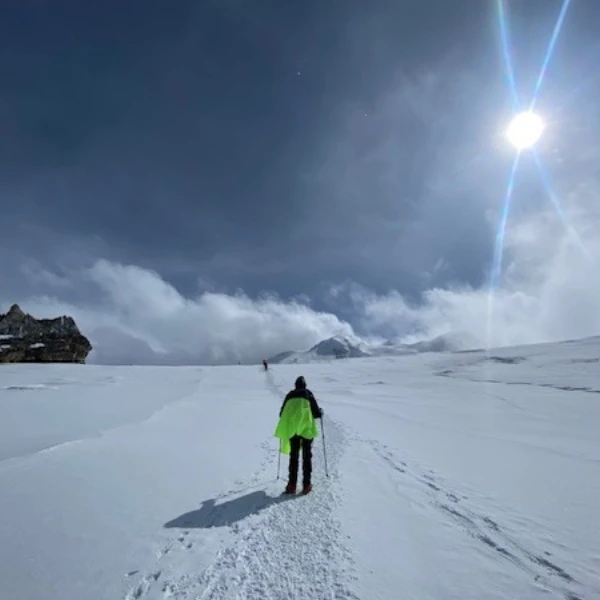Mountaineering in Nepal is known as one of the most beautiful and thrilling adventures in the world, which attracts climbers from every corner of the globe. Known for its majestic Himalayan range, mountaineering in Nepal has become a dream journey for mountaineers and trekkers, enabling them to undergo a journey of which most only dream of. Nepal proudly hosts eight of the world’s fourteen peaks over 8,000 meters, including the tallest peak in the world Mount Everest (8,848.86m), Kanchenjunga, Lhotse, and Annapurna. Mountaineers not only have multiple peaks to adventure to such as Mount Kanchanjunga, Mount Lhotse, and Mount Annapurna, but Nepal also provides valleys and deep waters while climbing. Since the historic 1953 summit by Hillary and Norgay, Nepal peak climbing has gained popularity, allowing and attracting climbers to challenge themselves on both technical 7,000-meter peaks Nepal and full-scale Himalayan expedition Nepal adventures. From Everest climbing in 2025 to other jaw-dropping ascents, the country has maintained its status as a go to go destination for high altitude climbing experiences in Nepal, supported by infrastructure of the world class and knowledgeable Nepalese Sherpa guides.
To take part in any Nepal climbing expeditions, obtaining the proper Nepal mountaineering permits is mandatory. These permits are issued by the Nepal government to ensure safety, environmental preservation, and regulatory compliance for all types of mountaineering in Nepal. As part of enhanced efforts to improve climber safety, the government has introduced stricter Nepal mountaineering regulations, especially concerning Everest climbing 2025, which now requires prior summiting of at least one 7,000-meter peak Nepal. The new policies make sure that climbers attempting to climb Everest or other high-risk peaks have sufficient high-altitude climbing experience within Nepal. In addition, to better manage expedition traffic and improve readiness of rescue, monitoring systems and digital tracking system have been implemented. All Himalayan expedition Nepal participants must be aware of the new rules and regulations to obtain their Nepal mountaineering permits, which supports responsible tourism. Following the Nepal mountaineering regulations helps protecting the fragile environment of the mountain and increases the effectiveness and safety of all Nepal peak climbing Expedition.
A key attribute of successful mountaineering in Nepal is the instruction and guidance from the expertise of Nepalese Sherpa guides. These highly skilled professionals are essential for anyone attempting Nepal climbing expeditions along Everest or the other 7,000-meter peaks of Nepal. Nepalese Sherpa Guides, with their knowledge of the terrain, weather, and high-altitude survival, play a vital role in expedition logistics, route setting, equipment handling, and emergency support during high altitude climbing in Nepal. Their assistance significantly boosts the likelihood of success on any Himalayan expedition Nepal, including the increasingly regulated Everest climbing 2025 season. Not only they have great physical capabilities, Sherpas also serves as cultural ambassadors and motivators, providing climbers guidance, encouragement, and emotional support during difficult situation. From guiding beginners during Nepal peak climbing experiences to assisting experienced climbers, the relationship between climbers and Sherpas reflects the spirit of cooperation that defines mountaineering in Nepal. Sherpas are not just porters but their contributions are also deeply cultural and serve as a connection to the heritage, spirituality, and resilience of the Himalayan people, who have inhabited and respected these mountains for countless generations.
For passionate adventurers, high altitude climbing Nepal offers more than just adrenaline, it provides a path to personal transformation. Climbers can pursue a variety of routes, from moderate Nepal peak climbing challenges to the toughest Nepal climbing expeditions on 7,000-meter peaks Nepal and above. Regardless of the chosen goal, all climbers must follow the Nepal mountaineering permits as well as the Nepal mountaineering regulations, which are frequently updated for safety and sustainability. These regulations emphasize environmental responsibility, climbing with the goal of preserving the untouched Himalayan ecosystem. Aspiring mountaineers preparing for Everest climbing 2025 must now prove their skills on lower peaks before trying to attempt the world’s highest summit, which aligns with the government's commitment to safety and responsible climbing. However, these efforts are supported by skilled Nepalese Sherpa guides, who are crucial in navigating the demanding conditions of Himalayan expedition Nepal ventures. While climbing, whether it is ascending the icy ridges, crossing glaciers, or adapting to constantly changing weather, climbers must depend on their skills and team effort. Altogether, the breathtaking and stunning scenery beauties, challenging routes, and constantly changing rules and regulations, Nepal offers one of the world’s most exciting and rewarding mountaineering experiences in the world.
